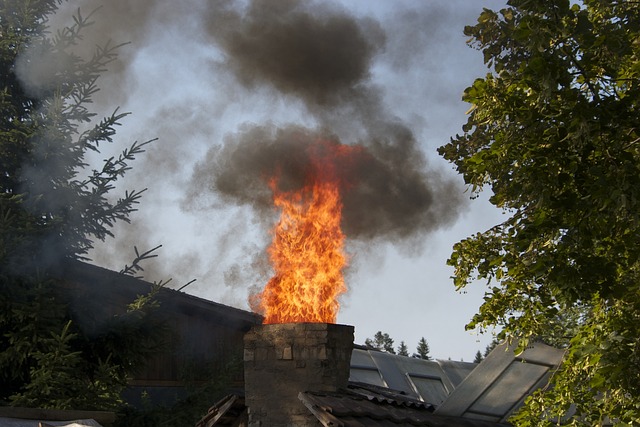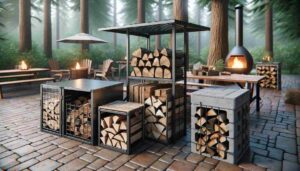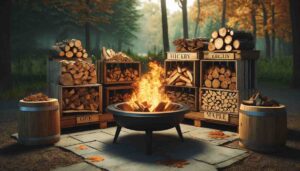Hey there! If you’re like me, there’s nothing quite like cozying up by the fireplace on a chilly evening, enjoying the crackling sound of burning wood and the comforting warmth it provides. But, have you ever wondered if those warm and inviting flames could potentially turn into a dangerous situation? Are chimney fires dangerous?
Yes, chimney fires are dangerous. They can cause structural damage to your chimney, spread to your home’s roof, release toxic gases, and even lead to house fires. Preventive measures like regular maintenance, proper burning practices, and using the right fuel are crucial to minimize the risk of chimney fires.
Now, let me share a little story with you. Last winter, as I was sipping my hot cocoa and gazing into the dancing flames, a friend of mine mentioned the term “chimney fire” in passing. It got me thinking – could this picturesque scene ever take a disastrous turn? This curiosity led me to dig deep into the topic, and I’m here to pass on what I’ve learned.
I’ll uncover the nitty-gritty details, discuss the potential dangers, and arm ourselves with essential knowledge to prevent these unwelcome surprises. After all, your fireplace should be a source of comfort, not a cause for concern.
Understanding Chimney Fires
Alright, let’s start by demystifying the science behind those crackling flames. You see, chimney fires are no urban legend – they’re a real thing, and they happen more often than you might think. So, what exactly causes these fiery incidents?
Creosote: The Culprit Picture this: Every time you light a fire in your fireplace, a substance called creosote is produced. Creosote is a sticky, tar-like residue that forms as a byproduct of burning wood. Now, here’s the catch – Creosote is highly flammable. Over time, if not properly managed, it builds up inside your chimney like a time bomb waiting to go off.
Ignition: Slow vs. Fast Fires Chimney fires come in two flavors: slow-burning and fast-burning. Slow-burning fires happen when the creosote deposits inside the chimney catch fire gradually. These fires might not produce dramatic flames, but they generate intense heat that can crack the chimney liner and compromise its structure.
On the other hand, fast-burning fires are more explosive. They occur when a significant amount of creosote ignites suddenly, leading to roaring flames shooting up the chimney. These fires can crack masonry, damage the flue, and even send sparks onto the roof – yikes!
A Chemistry Lesson Let’s break down the science a bit. As creosote accumulates in the chimney, it forms layers. The innermost layer is usually made up of a more powdery, ash-like substance, followed by increasingly thicker and stickier layers on the outside. It’s these outer layers that are the real troublemakers, as they’re the ones prone to igniting.
Remember, it’s not just about the quantity of creosote – the type matters too. Hard, glossy creosote is highly combustible, while the fluffy kind is less so. The goal? Keep those layers in check to avoid any fiery surprises.
So, now that I’ve got the chemistry lesson out of the way, let’s delve into the dangers these fires pose and why it’s crucial to take them seriously.
The Dangers of Chimney Fires
Now that I’ve unraveled the science behind chimney fires, let’s get real about the risks they pose. Trust me, it’s not just about the mesmerizing crackle of flames anymore – there’s a lot more at stake.
Structural Threats: Chimney fires can wreak havoc on your chimney’s structure. The intense heat generated during a fire can cause the masonry to crack and crumble, compromising its stability. This means your chimney might not be able to do its job properly – to safely direct smoke and gases out of your home.
Flames on the Move: Here’s a chilling thought: those flames inside your chimney aren’t always content with staying put. If the fire is fierce enough, it can actually leap from the chimney to your roof or other nearby areas. This isn’t just a fire safety concern; it’s a whole-house-in-danger situation.
Dangerous Gases: It’s not just the flames you need to worry about – chimney fires can release toxic gases like carbon monoxide into your living space. Carbon monoxide is odorless and deadly, and it can spread rapidly through your home without you even realizing it. Talk about a silent threat!
Insurance Nightmares: Ever heard the term “insurance claim”? Well, chimney fires can lead to a chaotic tango with insurance companies. Many policies require proof of regular chimney maintenance to cover any damages caused by chimney fires. Neglecting this aspect could leave you in a tough spot when you need financial help the most.
The Takeaway: Take It Seriously! The dangers of chimney fires are not to be underestimated. It’s not just about the aesthetic of a crackling fire; it’s about your home’s safety and the well-being of your loved ones.
Signs of Chimney Fires
How can you tell if a chimney fire is making an unwanted appearance in your cozy haven? Don’t worry – your chimney won’t send smoke signals or anything, but there are definitely signs you can watch out for.
- Unusual Sounds: Imagine you’re sitting by the fire, and suddenly, you hear loud cracking, popping, or rumbling noises coming from the chimney. These aren’t just regular fireplace sounds – they could be your chimney’s way of saying, “Hey, something’s not right!”
- Dense Smoke: We all love seeing that plume of smoke rise from the chimney, but if you notice an excessive amount of thick, dark smoke billowing out, it’s time to be concerned. This could be an indicator that a chimney fire is happening.
- Intense Odors: Sure, fireplaces have their own distinct scent, but if you’re detecting an unusually strong, acrid smell, it might be a sign that the fire burning in your chimney isn’t playing by the rules.
- Excessive Heat: Feeling like your fireplace and chimney are hotter than usual? That’s a red flag. Excessive heat could mean that a chimney fire is raging inside, and it’s getting a bit too close for comfort.
- Cracks and Damage: Inspect your chimney for visible cracks, splits, or any kind of damage. While not all chimney fires leave visible marks, some do, and these could be a clear indication that you’ve had an unwelcome visitor.
- Vibrations or Tremors: If you feel your chimney or even your home shaking or vibrating while using your fireplace, it’s a definite cause for concern. This might indicate a more intense chimney fire that’s causing structural stress.
What to Do: If you notice any of these signs, the first thing to do is stay calm. Close the fireplace damper to cut off the oxygen supply, which could help slow down or extinguish the fire. Then, call emergency services and have a professional chimney inspector assess the situation. Safety first, always!
Remember, recognizing these signs early could make all the difference. But hey, let’s not dwell on the negative stuff too long. In the next section, I’ll walk you through some super effective ways to prevent chimney fires from ever becoming a reality. Stay tuned!
Prevention and Maintenance
Now that you’re equipped with the knowledge of what chimney fires are and the signs they might give, let’s talk about how to avoid these fiery fiestas altogether. The good news is that prevention is absolutely possible, and it’s a lot easier than you might think!
- Regular Inspections and Cleanings: Consider this your chimney’s check-up. Schedule an annual inspection by a professional chimney sweep. They’ll make sure there’s no excessive creosote buildup and that your chimney is in tip-top shape. A clean chimney is a safe chimney.
- Choose the Right Wood: Not all firewood is created equal. Opt for well-seasoned hardwoods like oak, maple, or cherry. These burn cleaner and produce less creosote than softwoods. Remember, moisture is the enemy – using properly seasoned wood reduces creosote buildup.
- Proper Burning Techniques: Be a fire-smart homeowner! Burn fires hot and lively rather than low and slow. This helps reduce the accumulation of creosote. Don’t smother your fire with too much wood at once, and avoid closing the damper too early.
- Mind the Airflow: Good airflow equals a healthier fire. Ensure your fireplace vents and dampers are functioning properly to maintain an optimal burn. Proper ventilation also helps in minimizing creosote buildup.
- Install a Chimney Cap and Spark Arrestor: Think of these as your chimney’s protective gear. A chimney cap keeps debris, animals, and rain out, while a spark arrestor prevents sparks from escaping and potentially igniting nearby surfaces.
- Educate Your Household: Everyone under your roof should know the dos and don’ts of fireplace usage. Teach your family about the importance of responsible burning, recognizing signs of chimney issues, and what to do in case of an emergency.
- Stay Away from Accelerants: Gasoline, kerosene, and other accelerants have no place in your fireplace. Using them can lead to uncontrollable fires, excessive creosote buildup, and potentially disastrous consequences.
- Keep Your Roof Clear: Trim tree branches that hang over your chimney and roof. This prevents debris from accumulating and potentially igniting during a chimney fire.
Remember, a little preventive action goes a long way in keeping your fireplace both enjoyable and safe. Take these steps seriously, and you’ll be savoring cozy nights worry-free.
Safe Fireplace Practices
Let’s talk about some safe practices that’ll help you enjoy your fireplace to the fullest without any unexpected surprises.
- Clear the Zone: Think of your fireplace as a cozy stage, and the area around it needs to be clear. Keep all flammable materials – like furniture, curtains, and decorations – at a safe distance. A clear space ensures sparks won’t find anything to ignite.
- Use a Screen or Glass Doors: A fireplace screen or glass doors are like a protective shield. They prevent sparks from jumping out and keep curious fingers (or paws) from getting too close to the flames.
- Never Leave Unattended: Just like you wouldn’t leave a pot unattended on the stove, the same goes for your fireplace. Always supervise your fire and make sure it’s properly extinguished before you leave the room.
- Mind the Damper: When your fireplace isn’t in use, close the damper. This prevents warm air from escaping up the chimney and cold drafts from entering your home.
- Properly Extinguish Fires: When you’re done enjoying your fire, extinguish it completely. Use water or sand, not just ashes, to ensure no embers are left smoldering.
- Keep Children and Pets in Check: Both little ones and furry friends are naturally curious. Use a safety gate to keep them a safe distance from the flames, and teach them that the fireplace isn’t a play area.
- Don’t Overload the Fireplace: Resist the urge to pile your fireplace with more wood than it can handle. Overloading can lead to poor airflow, incomplete burning, and excessive creosote buildup.
- Store Firewood Safely: Keep firewood away from your home’s exterior to prevent pests and moisture from infiltrating your space. A dry, well-ventilated wood storage area is your best bet.
- Check Smoke Detectors: Regularly test and replace the batteries in your smoke detectors. These little devices can be lifesavers by alerting you to any smoke or fire emergencies.
- Practice Responsible Ash Disposal: Wait until ashes are completely cool before removing them from the fireplace. Store them in a metal container with a tight-fitting lid, away from your home, until you’re sure they’re fully extinguished.
Remember, the key is to balance the enjoyment with a good dose of caution. Now that you’re well-versed in fireplace safety, let’s explore one more critical aspect: the kind of fuel you use to light those fires. Keep reading for insights that’ll help you make the right choices.
Choosing the Right Fuel
Now that you’re a fireplace safety pro, let’s dive into a topic that directly affects both your comfort and safety: choosing the right fuel for your fires. From classic wood to modern alternatives, let’s explore your options.
- Traditional Wood: Wood is the classic choice, providing that authentic crackling ambiance. However, not all woods are created equal. Opt for hardwoods like oak, maple, or cherry. They burn hotter and produce less creosote compared to softwoods.
- Manufactured Logs: If you’re looking for convenience, manufactured logs could be your jam. These compressed logs are often made from sawdust and wax, producing less creosote and fewer emissions than traditional wood. They can be a great option for an occasional fire.
- Pellet Stoves: Pellet stoves are like the modern cousin of a traditional fireplace. They burn compacted wood pellets, which are highly efficient and produce minimal creosote. They’re great for heating purposes and are environmentally friendly.
- Gas Fireplaces: Gas fireplaces offer the ultimate in convenience. With just a flip of a switch, you’ve got flames. They burn clean and don’t produce creosote, but they lack the natural ambiance of a wood-burning fire.
- Ethanol Fireplaces: Ethanol fireplaces run on bioethanol, a renewable fuel source. They’re easy to install, produce real flames without a chimney, and require minimal maintenance. However, they might not provide as much heat as traditional fireplaces.
- Electric Fireplaces: If you’re looking for a no-fuss option, electric fireplaces are your answer. They mimic flames with electricity and can be placed anywhere you have an outlet. They’re safe and efficient, but keep in mind they won’t produce real heat like other options.
- Hybrid Fireplaces: Some fireplaces offer the best of both worlds – you can switch between wood and gas, for example. These versatile options give you the flexibility to choose based on your mood and needs.
The Bottom Line: When choosing a fuel, consider your priorities – ambiance, convenience, or heating efficiency. Each type has its pros and cons, but the key is to use the right fuel for your fireplace type and maintain safe practices no matter what you burn.
Educating Family Members
You’re armed with a wealth of knowledge about chimney fire risks, prevention, and responsible fireplace practices. But, remember, you’re not alone in this journey. It’s vital to make sure everyone under your roof is on the same page when it comes to fireplace safety. Here’s how to get the whole family in on the action:
- Family Meeting: Gather the troops for a casual family meeting. Make it fun by including some snacks or treats. Discuss the importance of fireplace safety and the potential risks of neglecting it.
- Show and Tell: Use visuals to get your message across. Show your family members what creosote buildup looks like and how it can lead to chimney fires. Sometimes seeing is believing!
- Explain the Signs: Teach your family members how to recognize signs of chimney fires, such as unusual sounds, excessive smoke, and intense odors. Emphasize that if they notice any of these signs, they should alert an adult immediately.
- Emergency Plan: Outline a clear plan of action in case of a chimney fire. Teach your family how to use the fire extinguisher, where to find it, and how to call emergency services.
- Responsible Practices: Discuss safe fireplace practices together. Explain why it’s important to never overload the fireplace, always use a screen, and never leave the fire unattended.
- Importance of Clear Space: Emphasize the significance of keeping the area around the fireplace clutter-free. Show them that decorations, papers, or other flammable items should be far away from the flames.
- Fire Safety Tools: Introduce your family to fire safety tools like fire extinguishers, smoke detectors, and carbon monoxide alarms. Teach them how to use these devices and why they’re essential.
- Fire Safety Drills: Just like you practice fire drills at school or work, do the same at home. Run through different scenarios to ensure everyone knows how to respond calmly and efficiently.
- Lead by Example: Children often learn by observing. Set a great example by consistently following safe fireplace practices. When they see you taking safety seriously, they’re more likely to do the same.
- Open Communication: Keep the lines of communication open. Encourage your family members to ask questions, express concerns, and share what they’ve learned.
Conclusion
In conclusion, chimney fires are unquestionably dangerous. Beyond the crackling flames lies a potential threat to your home’s structural integrity, the safety of your loved ones, and even your insurance coverage. Vigilance, regular maintenance, and responsible fireplace practices are your allies in mitigating this risk. Remember, a well-informed homeowner is a safer homeowner.
Let’s recap the key takeaways that will stick with you:
- Creosote Buildup: Remember that creosote is the sneaky culprit behind chimney fires. Regular maintenance and cleaning are your best defenses against this flammable substance.
- Dangers of Chimney Fires: Chimney fires are no joke – they can compromise your chimney’s structure, spread flames to your roof, release toxic gases, and even create insurance nightmares.
- Signs to Watch For: Be vigilant for signs of chimney fires, such as unusual sounds, dense smoke, intense odors, and more. Recognizing these signs early can make all the difference.
- Prevention is Key: Regular inspections, proper burning techniques, and the right fuel choice are your weapons against chimney fires. Prevention starts with responsible fireplace practices.
- Safe Fireplace Habits: Clear zones, proper extinguishing, using screens, and keeping children and pets away are all part of being a responsible fireplace owner.
- Choosing the Right Fuel: Whether you prefer wood, manufactured logs, pellets, or gas, make the right choice for your needs and ensure you’re using it safely.
- Family Education: Sharing your knowledge with your family ensures everyone is on the same page when it comes to fireplace safety. From recognizing signs of danger to practicing safe habits, your loved ones will be well-prepared.
Remember, the joy of a cozy fireplace doesn’t have to come at the expense of safety. By following the practices and insights shared in this article, you’re not just preventing potential disasters – you’re nurturing an environment where warmth and comfort coexist harmoniously. So, go ahead, light that fire, gather around, and relish the comforting embrace of your fireplace, knowing you’ve taken every step to keep your home safe and sound. Here’s to many safe and enjoyable fireside moments ahead!
Check my latest article: Do Pallets Make Good Firewood? Exploring The Pros And Cons










